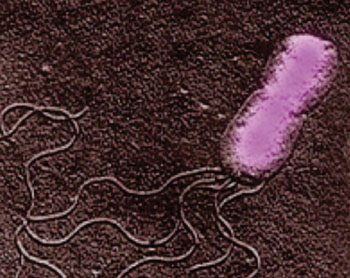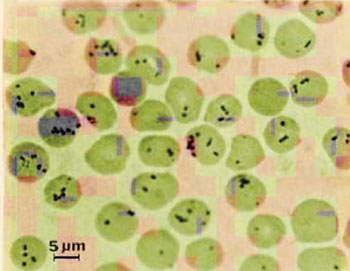Emerging Blood-Borne Bacteria Found in Blood Donors
|
By LabMedica International staff writers Posted on 04 Apr 2016 |

Image: Electron micrograph of Bartonella henelae, Gram-negative bacteria that causes cat scratch fever (Photo courtesy of the Prokaryotes).

Image: Stained Bartonella bacilliformis in a blood film of an Oroyo fever infected human (Photo courtesy of the Prokaryotes).
Bartonella species cause chronic and intermittent intra-erythrocytic bacteremia and infect endothelial cells of both incidental and natural reservoir hosts. The establishment of chronic, stealth infection is achieved by evasion of innate immune responses.
In humans, Bartonella species have been detected from sick patients presented with diverse disease manifestations, including cat scratch disease, trench fever, bacillary angiomatosis, endocarditis, polyarthritis, or granulomatous inflammatory disease.
An international team of scientists, led by those at the Western University of Health Sciences, Pomona, CA, USA), collected blood from 500 apparently healthy Brazilian voluntary blood donors in a cross sectional study. Bartonella species infection from the bloodstream was detected based on enrichment blood culture in a liquid growth medium (Bartonella alpha-Proteobacteria growth medium-BAPGM), coupled with isolation in solid medium. Bartonella-specific DNA was amplified by polymerase chain reaction (PCR), followed by DNA sequencing to confirm species identification. Of the ten Bartonella species that are believed to produce infection in humans, the most commonly encountered are B. henselae, B. quintana, and B. bacilliformis. The latter causes Oroya fever and Verruga peruana.
Bartonella species bloodstream infection was detected in 16/500 blood donors (3.2%). DNA amplification and sequencing identified B. henselae in 15 blood donors (3%) and B. clarridgeiae in one donor (0.2%). B. henselae bacteremia was also confirmed in six donors by bacterial isolation. Adjusted odds ratio indicated that subjects with cat contact, or past history of tick bite, were approximately three to four times more likely to have a Bartonella species infection than donors without cat contact or lack of history of tick bite.
The authors concluded that the risk factors of cat contact or tick bites should be considered during donor screening, as bacteremia by these Bartonella species may not be detected by traditional laboratory screening methods, and it may be transmitted by blood transfusion. The study was published on March 21, 2016, in the journal Public Library of Science Neglected Tropical Diseases.
Related Links:
Western University of Health Sciences
In humans, Bartonella species have been detected from sick patients presented with diverse disease manifestations, including cat scratch disease, trench fever, bacillary angiomatosis, endocarditis, polyarthritis, or granulomatous inflammatory disease.
An international team of scientists, led by those at the Western University of Health Sciences, Pomona, CA, USA), collected blood from 500 apparently healthy Brazilian voluntary blood donors in a cross sectional study. Bartonella species infection from the bloodstream was detected based on enrichment blood culture in a liquid growth medium (Bartonella alpha-Proteobacteria growth medium-BAPGM), coupled with isolation in solid medium. Bartonella-specific DNA was amplified by polymerase chain reaction (PCR), followed by DNA sequencing to confirm species identification. Of the ten Bartonella species that are believed to produce infection in humans, the most commonly encountered are B. henselae, B. quintana, and B. bacilliformis. The latter causes Oroya fever and Verruga peruana.
Bartonella species bloodstream infection was detected in 16/500 blood donors (3.2%). DNA amplification and sequencing identified B. henselae in 15 blood donors (3%) and B. clarridgeiae in one donor (0.2%). B. henselae bacteremia was also confirmed in six donors by bacterial isolation. Adjusted odds ratio indicated that subjects with cat contact, or past history of tick bite, were approximately three to four times more likely to have a Bartonella species infection than donors without cat contact or lack of history of tick bite.
The authors concluded that the risk factors of cat contact or tick bites should be considered during donor screening, as bacteremia by these Bartonella species may not be detected by traditional laboratory screening methods, and it may be transmitted by blood transfusion. The study was published on March 21, 2016, in the journal Public Library of Science Neglected Tropical Diseases.
Related Links:
Western University of Health Sciences
Latest Hematology News
- New Scoring System Predicts Risk of Developing Cancer from Common Blood Disorder
- Non-Invasive Prenatal Test for Fetal RhD Status Demonstrates 100% Accuracy
- WBC Count Could Predict Severity of COVID-19 Symptoms
- New Platelet Counting Technology to Help Labs Prevent Diagnosis Errors
- Streamlined Approach to Testing for Heparin-Induced Thrombocytopenia Improves Diagnostic Accuracy
- POC Hemostasis System Could Help Prevent Maternal Deaths
- New Test Assesses Oxygen Delivering Ability of Red Blood Cells by Measuring Their Shape
- Personalized CBC Testing Could Help Diagnose Early-Stage Diseases in Healthy Individuals
- Non-Invasive Test Solution Determines Fetal RhD Status from Maternal Plasma
- First-Of-Its-Kind Smartphone Technology Noninvasively Measures Blood Hemoglobin Levels at POC

- Next Gen CBC and Sepsis Diagnostic System Targets Faster, Earlier, Easier Results
- Newly Discovered Blood Group System to Help Identify and Treat Rare Patients
- Blood Platelet Score Detects Previously Unmeasured Risk of Heart Attack and Stroke
- Automated Benchtop System to Bring Blood Testing To Anyone, Anywhere
- New Hematology Analyzers Deliver Combined ESR and CBC/DIFF Results in 60 Seconds
- Next Generation Instrument Screens for Hemoglobin Disorders in Newborns
Channels
Clinical Chemistry
view channel
Carbon Nanotubes Help Build Highly Accurate Sensors for Continuous Health Monitoring
Current sensors can measure various health indicators, such as blood glucose levels, in the body. However, there is a need to develop more accurate and sensitive sensor materials that can detect lower... Read more
Paper-Based Device Boosts HIV Test Accuracy from Dried Blood Samples
In regions where access to clinics for routine blood tests presents financial and logistical obstacles, HIV patients are increasingly able to collect and send a drop of blood using paper-based devices... Read moreMolecular Diagnostics
view channel
D-Dimer Testing Can Identify Patients at Higher Risk of Pulmonary Embolism
Pulmonary embolism (PE) is a commonly suspected condition in emergency departments (EDs) and can be life-threatening if not diagnosed correctly. Achieving an accurate diagnosis is vital for providing effective... Read more
New Biomarkers to Improve Early Detection and Monitoring of Kidney Injury
Drug-induced kidney injury, also known as nephrotoxicity, is a prevalent issue in clinical practice, occurring when specific medications at certain doses cause damage to the kidneys. Nephrotoxicity can... Read moreImmunology
view channel
Post-Treatment Blood Test Could Inform Future Cancer Therapy Decisions
In the ongoing advancement of personalized medicine, a new study has provided evidence supporting the use of a tool that detects cancer-derived molecules in the blood of lung cancer patients years after... Read more
Cerebrospinal Fluid Test Predicts Dangerous Side Effect of Cancer Treatment
In recent years, cancer immunotherapy has emerged as a promising approach where the patient's immune system is harnessed to fight cancer. One form of immunotherapy, called CAR-T-cell therapy, involves... Read more
New Test Measures Preterm Infant Immunity Using Only Two Drops of Blood
Preterm infants are particularly vulnerable due to their organs still undergoing development, which can lead to difficulties in breathing, eating, and regulating body temperature. This is especially true... Read more
Simple Blood Test Could Help Choose Better Treatments for Patients with Recurrent Endometrial Cancer
Endometrial cancer, which develops in the lining of the uterus, is the most prevalent gynecologic cancer in the United States, affecting over 66,000 women annually. Projections indicate that in 2025, around... Read moreMicrobiology
view channel
Breakthrough Diagnostic Technology Identifies Bacterial Infections with Almost 100% Accuracy within Three Hours
Rapid and precise identification of pathogenic microbes in patient samples is essential for the effective treatment of acute infectious diseases, such as sepsis. The fluorescence in situ hybridization... Read more
Innovative ID/AST System to Help Diagnose Infectious Diseases and Combat AMR
Each year, 11 million people across the world die of sepsis out of which 1.3 million deaths are due to antibiotic-resistant bacteria. The burden of antimicrobial resistance (AMR) continues to weigh heavily,... Read more
Gastrointestinal Panel Delivers Rapid Detection of Five Common Bacterial Pathogens for Outpatient Use
Acute infectious gastroenteritis results in approximately 179 million cases each year in the United States, leading to a significant number of outpatient visits and hospitalizations. To address this, a... Read morePathology
view channel
AI Model Predicts Patient Response to Bladder Cancer Treatment
Each year in the United States, around 81,000 new cases of bladder cancer are diagnosed, leading to approximately 17,000 deaths annually. Muscle-invasive bladder cancer (MIBC) is a severe form of bladder... Read more
New Laser-Based Method to Accelerate Cancer Diagnosis
Researchers have developed a method to improve cancer diagnostics and other diseases. Collagen, a key structural protein, plays various roles in cell activity. A novel multidisciplinary study published... Read more
New AI Model Predicts Gene Variants’ Effects on Specific Diseases
In recent years, artificial intelligence (AI) has greatly enhanced our ability to identify a vast number of genetic variants in increasingly larger populations. However, up to half of these variants are... Read more
Powerful AI Tool Diagnoses Coeliac Disease from Biopsy Images with Over 97% Accuracy
Coeliac disease is an autoimmune disorder triggered by the consumption of gluten, causing symptoms such as stomach cramps, diarrhea, skin rashes, weight loss, fatigue, and anemia. Due to the wide variation... Read moreTechnology
view channel
Smartphones Could Diagnose Diseases Using Infrared Scans
Rapid advancements in technology may soon make it possible for individuals to bypass invasive medical procedures by simply uploading a screenshot of their lab results from their phone directly to their doctor.... Read more
Novel Sensor Technology to Enable Early Diagnoses of Metabolic and Cardiovascular Disorders
Metabolites are critical compounds that fuel life's essential functions, playing a key role in producing energy, regulating cellular activities, and maintaining the balance of bodily systems.... Read more
3D Printing Breakthrough Enables Large Scale Development of Tiny Microfluidic Devices
Microfluidic devices are diagnostic systems capable of analyzing small volumes of materials with precision and speed. These devices are used in a variety of applications, including cancer cell analysis,... Read moreIndustry
view channel



















